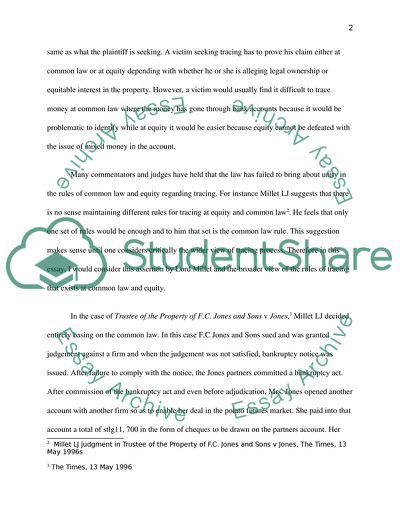Cite this document
(Tracing Rules at Law and in Equity Case Study Example | Topics and Well Written Essays - 2000 words, n.d.)
Tracing Rules at Law and in Equity Case Study Example | Topics and Well Written Essays - 2000 words. Retrieved from https://studentshare.org/law/1750875-critically-evaluate-with-reference-to-the-relavent-case-law-millets-lj-observation-in-f-c-jones-sons-v-jones-1996-that-there-is-no-merit-in-having-different-tracing-rules-at-law-and-in-equity
Tracing Rules at Law and in Equity Case Study Example | Topics and Well Written Essays - 2000 words. Retrieved from https://studentshare.org/law/1750875-critically-evaluate-with-reference-to-the-relavent-case-law-millets-lj-observation-in-f-c-jones-sons-v-jones-1996-that-there-is-no-merit-in-having-different-tracing-rules-at-law-and-in-equity
(Tracing Rules at Law and in Equity Case Study Example | Topics and Well Written Essays - 2000 Words)
Tracing Rules at Law and in Equity Case Study Example | Topics and Well Written Essays - 2000 Words. https://studentshare.org/law/1750875-critically-evaluate-with-reference-to-the-relavent-case-law-millets-lj-observation-in-f-c-jones-sons-v-jones-1996-that-there-is-no-merit-in-having-different-tracing-rules-at-law-and-in-equity.
Tracing Rules at Law and in Equity Case Study Example | Topics and Well Written Essays - 2000 Words. https://studentshare.org/law/1750875-critically-evaluate-with-reference-to-the-relavent-case-law-millets-lj-observation-in-f-c-jones-sons-v-jones-1996-that-there-is-no-merit-in-having-different-tracing-rules-at-law-and-in-equity.
“Tracing Rules at Law and in Equity Case Study Example | Topics and Well Written Essays - 2000 Words”, n.d. https://studentshare.org/law/1750875-critically-evaluate-with-reference-to-the-relavent-case-law-millets-lj-observation-in-f-c-jones-sons-v-jones-1996-that-there-is-no-merit-in-having-different-tracing-rules-at-law-and-in-equity.


